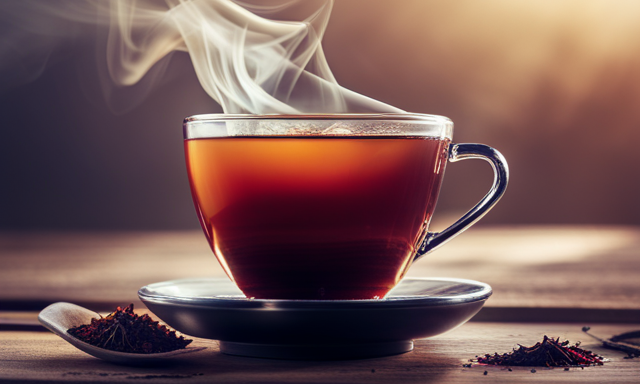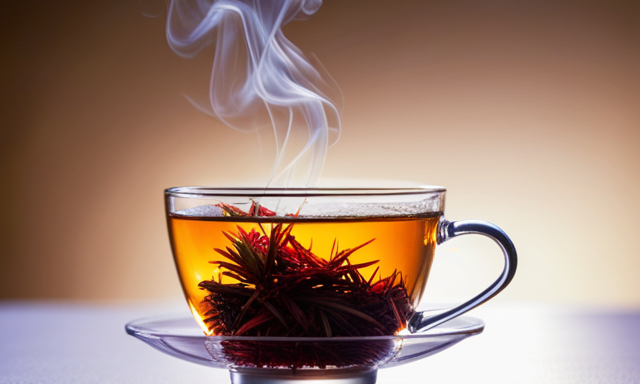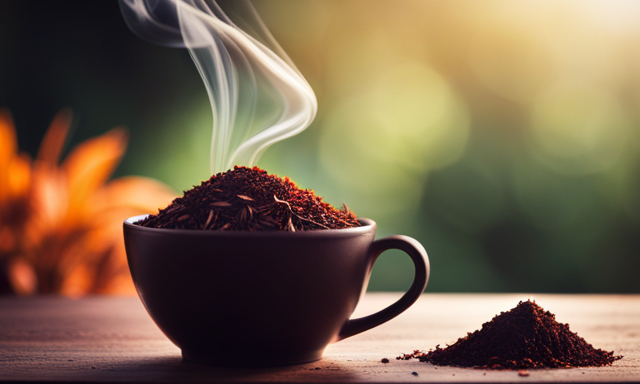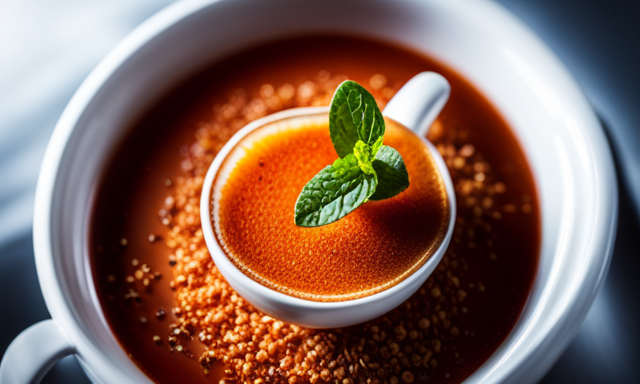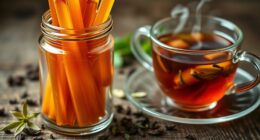Did you know that rooibos tea is not actually a tea, but rather an herbal infusion? That’s just one fascinating fact about this delicious and healthful beverage.
As a passionate tea enthusiast, I am excited to share with you all the wonders of rooibos tea in this article.
Rooibos tea has a rich history and originates from the Cederberg region in South Africa. It has been enjoyed for centuries by the indigenous people for its numerous health benefits and unique flavor profile. The production process involves carefully harvesting the leaves, fermenting them, and then drying them in the sun.
One of the standout features of rooibos tea is its remarkable versatility. It can be enjoyed hot or iced, and its natural sweetness makes it a perfect choice for blending with other herbs and flavors.
In this article, I will delve into the origins, production process, health benefits, and various ways to enjoy rooibos tea. I will also provide tips on brewing the perfect cup and where to find the best rooibos tea.
So, grab your favorite mug and let’s explore the world of rooibos tea together!
Key Takeaways
- Rooibos tea has skincare benefits such as reducing fine lines and wrinkles, soothing sensitive or irritated skin, calming inflammation and redness, and improving overall skin health.
- Brewing rooibos tea properly involves heating water to 200°F, pouring hot water over rooibos leaves in a teapot or infuser, steeping for 5-7 minutes, and then straining and pouring into a cup.
- Popular rooibos tea blends include Rooibos Chai (sweet with cinnamon, cardamom, and cloves), Rooibos Vanilla (creamy with notes of vanilla), and Rooibos Berry (summer flavors with strawberry, raspberry, and blueberry).
- Rooibos tea can be purchased from local specialty tea shops or online retailers, and it should be stored in an airtight container away from sunlight and moisture in a cool and dark place to extend its shelf life and preserve freshness and flavor.
Origins and History of Rooibos Tea
The rich and vibrant history of rooibos tea will transport you to the sun-kissed plains of South Africa.
Rooibos tea, also known as red bush tea, has been enjoyed for centuries by the indigenous people of the region. Known for its distinct reddish color and sweet, earthy flavor, rooibos tea has gained popularity worldwide for its numerous health benefits.
Rich in antioxidants, vitamins, and minerals, this herbal infusion is believed to support immune health, aid digestion, and promote healthy skin. Traditionally, rooibos tea was used by the Khoisan people to treat various ailments, including allergies, colic, and skin irritations.
Today, it is enjoyed both hot and cold, and its versatility has led to the creation of various rooibos tea blends. Moving on to the production and harvesting process, let’s explore how this delightful tea is made.
Production and Harvesting Process
During the production and harvesting process, farmers carefully cultivate and pluck the leaves of the indigenous South African plant. To ensure the highest quality, they follow specific production techniques that have been passed down for generations. Here are three interesting facts about the production and harvesting of rooibos tea:
-
Handpicking: Each leaf is meticulously plucked by hand, ensuring only the finest leaves are used for tea production. This labor-intensive process guarantees that every cup of rooibos tea is of exceptional quality.
-
Fermentation: After the leaves are harvested, they undergo a natural fermentation process. This step is crucial in developing the tea’s distinct flavor and deep red color. It’s carefully monitored to achieve the perfect balance of flavors.
-
Sustainability practices: Rooibos tea farming embraces sustainable practices. Farmers use organic fertilizers and traditional crop rotation methods to maintain the health and fertility of the soil. They also prioritize water conservation, using drip irrigation systems to minimize water usage.
With the production and harvesting complete, let’s explore the unique flavor profile and aroma of rooibos tea.
Unique Flavor Profile and Aroma
Once the leaves have been carefully handpicked and fermented, their unique flavor profile and aroma come to life. Rooibos tea is known for its distinct taste and fragrance, which sets it apart from other types of tea. It has a naturally sweet and nutty flavor, with hints of vanilla and honey. The aroma is soothing and earthy, with a subtle floral undertone. To give you a better understanding of the flavor profile, here is a table showcasing the different taste notes found in rooibos tea:
| Taste Note | Description |
|---|---|
| Sweet | Similar to honey or sugar |
| Nutty | Reminiscent of almonds |
| Vanilla | Smooth and creamy |
| Earthy | Rich and grounding |
Rooibos tea’s flavor profile makes it a versatile beverage that can be enjoyed on its own or used as a base for other drinks. It pairs well with various ingredients, allowing for endless possibilities. Now, let’s explore the health benefits of rooibos tea.
Health Benefits of Rooibos Tea
Let’s now delve into the many health benefits that can be derived from enjoying a cup of this delightful brew. Rooibos tea is not only known for its unique flavor and aroma but also for its numerous health benefits.
One of the key benefits of rooibos tea is its positive impact on digestion. It contains antioxidants and anti-inflammatory properties that can help soothe the digestive system, relieve stomach cramps, and reduce bloating.
Additionally, rooibos tea is caffeine-free, making it a great choice for those who struggle with sleep quality. It has been found to promote relaxation and improve sleep patterns, allowing for a more restful night’s sleep.
So, not only does rooibos tea offer a delicious taste, but it also provides benefits for digestion and can help improve sleep quality.
Now, let’s explore the versatile uses of rooibos tea.
Versatile Uses of Rooibos Tea
When it comes to versatile uses, Rooibos tea has got you covered. Not only can you enjoy it as a hot or cold beverage, but it can also be used in cooking and baking to add a unique flavor profile.
Additionally, Rooibos tea has skincare and beauty applications, making it a multi-purpose ingredient that can be incorporated into your daily routine.
Hot and Cold Beverage Options
There are plenty of options for both hot and cold beverages, but one that stands out is rooibos tea, known as the ‘red bush.’ When it comes to hot beverage recipes, rooibos tea can be brewed and enjoyed on its own or used as a base for various flavorful concoctions. You can add spices like cinnamon and ginger for a cozy and aromatic cup, or mix it with honey and lemon for a soothing drink when you have a sore throat.
On the other hand, rooibos tea is also perfect for cold brewing, which retains its natural sweetness and health benefits. Cold brewing allows the tea to infuse slowly, resulting in a refreshing and antioxidant-rich beverage.
Now, let’s move on to the exciting culinary uses in cooking and baking, where rooibos tea adds a unique touch to a range of dishes.
Culinary Uses in Cooking and Baking
An elegant touch can be added to a variety of dishes through the culinary uses of rooibos tea in cooking and baking. It’s not just a beverage, but a versatile ingredient that can enhance the flavors of your favorite recipes.
Here are four exciting ways to incorporate rooibos tea into your culinary creations:
-
Marinades: Infuse your meat, poultry, or tofu with the earthy and slightly sweet flavors of rooibos tea. It adds a unique twist to traditional marinades and helps tenderize the proteins.
-
Desserts: From cakes and cookies to ice cream and custards, rooibos tea can elevate your sweet treats. Its subtle flavors complement chocolate, citrus, and vanilla, making it a delightful addition to any dessert recipe.
-
Sauces and glazes: Create a rich and flavorful sauce or glaze by steeping rooibos tea in broth, wine, or vinegar. It adds depth and complexity to your dishes, whether you’re making a savory meat dish or a tangy salad dressing.
-
Pairing suggestions: Rooibos tea pairs well with ingredients like cinnamon, ginger, honey, and citrus fruits. Try using it in recipes that feature these flavors for a harmonious combination.
With its versatility and delicate taste, rooibos tea is a secret ingredient that can transform your culinary recipes.
Now, let’s explore its skincare and beauty applications.
Skincare and Beauty Applications
You’ll be amazed at the incredible ways you can incorporate this versatile ingredient into your skincare and beauty routines, giving you a radiant and glowing complexion like never before!
Rooibos tea offers numerous skincare benefits, making it a popular choice for DIY beauty recipes. Its high antioxidant content helps to fight free radicals and reduce signs of aging, such as fine lines and wrinkles. Rooibos tea is also known for its soothing properties, making it ideal for those with sensitive or irritated skin. It can help to calm inflammation and redness, resulting in a more even skin tone. Additionally, using rooibos tea in your beauty routine can assist in reducing acne and improving overall skin health.
Now that you know the amazing skincare benefits of rooibos tea, let’s dive into how to brew the perfect cup, ensuring you get the most out of this wonderful ingredient.
How to Brew the Perfect Cup of Rooibos Tea
To achieve the pinnacle of tea brewing, it’s essential to master the art of preparing a flawless cup of rooibos tea.
Rooibos tea is known for its delicate flavors and health benefits, and brewing it properly is key to experiencing its full potential. Start by heating water to about 200°F, then pour it over a teaspoon of rooibos leaves in a teapot or infuser.
Let it steep for 5-7 minutes to allow the flavors to fully develop. This longer brewing time brings out the rich, earthy notes of the tea. Once the steeping is complete, strain the tea and pour it into your favorite cup.
The result will be a warm, soothing beverage that’s both refreshing and comforting.
Now, let’s explore the world of popular rooibos tea blends and flavors.
Popular Rooibos Tea Blends and Flavors
Sipping on sensational and satisfying blends of rooibos tea is a delightful way to explore a world of flavors and aromas. Rooibos tea blends offer a wide variety of options to suit every taste. From fruity infusions to spiced concoctions, there is something for everyone. One popular blend is the Rooibos Chai, which combines the earthy sweetness of rooibos with the warm and comforting flavors of cinnamon, cardamom, and cloves. Another delightful option is the Rooibos Vanilla, where the natural sweetness of rooibos is enhanced by the creamy and smooth notes of vanilla. For those who prefer a fruity twist, the Rooibos Berry blend provides a burst of summer flavors with the addition of berries like strawberry, raspberry, and blueberry. The possibilities are endless when it comes to rooibos tea flavors. Transitioning into the next section about where to buy rooibos tea and tips for storage, exploring these blends will surely leave you craving for more.
Where to Buy Rooibos Tea and Tips for Storage
Now that we know about the popular blends and flavors of Rooibos tea, let’s explore where we can buy this delightful beverage and some tips for proper storage.
When it comes to buying Rooibos tea, there are several options available. Firstly, you can purchase it from local specialty tea shops, where you can find a wide variety of brands and flavors. Another convenient option is to buy Rooibos tea online, from reputable websites that offer a diverse selection and deliver to your doorstep.
As for storage, it’s important to keep Rooibos tea in an airtight container, away from direct sunlight and moisture. This will help preserve its freshness and flavor. Additionally, storing it in a cool and dark place, such as a pantry or cupboard, will further extend its shelf life.
Remember, proper storage is key to enjoying the full benefits of Rooibos tea.
- Local specialty tea shops
- Online retailers
- Airtight container storage
Frequently Asked Questions
Can rooibos tea be consumed by people with certain health conditions or on certain medications?
Rooibos tea can be consumed by people with certain health conditions or on certain medications. It is generally considered safe and does not interact with most medications. However, it is always best to consult with a healthcare professional for personalized advice.
Are there any potential side effects or risks associated with drinking rooibos tea?
Potential interactions or allergic reactions may occur when drinking rooibos tea. It is important to consider any medications or health conditions that could be affected. It is always best to consult a healthcare professional for personalized advice.
Can rooibos tea help with weight loss or managing diabetes?
Rooibos tea can be beneficial for weight loss due to its low-calorie content and ability to suppress appetite. While it may help manage diabetes by regulating blood sugar levels, it’s important to consult a healthcare professional for personalized advice.
Is rooibos tea safe for pregnant women or breastfeeding mothers?
Rooibos tea is generally considered safe for pregnant women and breastfeeding mothers. It has no known safety concerns and can even provide benefits like hydration, antioxidants, and relief from pregnancy discomforts.
Can rooibos tea be used topically for skincare or haircare purposes?
Rooibos tea has numerous benefits for skincare. Its antioxidant properties help fight free radicals, reducing signs of aging. It also soothes and hydrates the skin, leaving it radiant. Additionally, it stimulates hair growth and nourishes the scalp, promoting healthy hair.
Conclusion
Overall, I highly recommend trying rooibos tea if you haven’t already. Its rich history and unique flavor profile make it a truly special beverage.
From its origins in South Africa to its versatile uses, rooibos tea has a lot to offer. Plus, the health benefits are numerous, making it a great choice for those looking to improve their well-being.
So, why not brew a cup of rooibos tea today and experience the wonders of this ‘red bush’ for yourself? It’s the perfect way to relax and unwind, leaving you feeling as happy as a clam.

